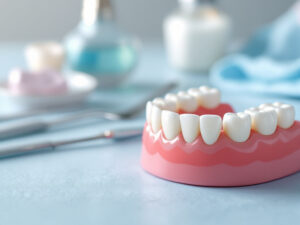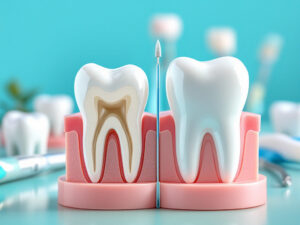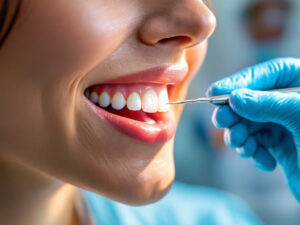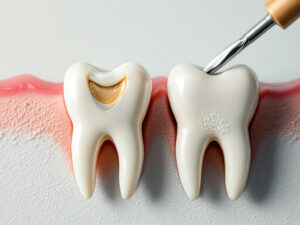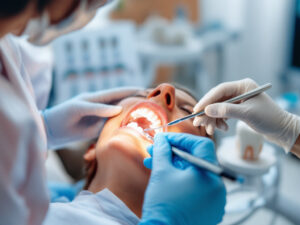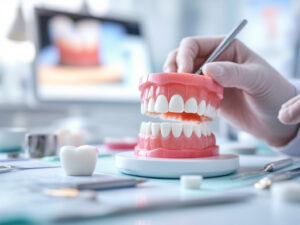Discover cosmetic bonding
Choosing a cosmetic bonding service can be a transformative step toward a healthier, more confident smile. At Cloninger Dentistry, we understand that every smile comes with unique challenges, whether you are trying to correct minor chips or hoping for a solution to mild discoloration. By offering a supportive environment and comprehensive care, we strive to ensure that you receive a tailored treatment program that fits comfortably into your lifestyle. Our approach combines empathy with expertise, empowering you to seek the support necessary for lasting improvements in your oral health.
Cosmetic bonding, also known as tooth bonding or composite bonding, involves the application of a tooth-colored resin material to correct imperfections such as chips, gaps, or discoloration. This procedure is minimally invasive relative to other cosmetic dentistry approaches. According to the Cleveland Clinic, dental bonding is one of the most frequently performed procedures in cosmetic dentistry today and is often considered a cost-effective way to rejuvenate your smile (Cleveland Clinic).
When you arrive for your first appointment, you may be unsure if cosmetic bonding is right for you. During your initial cosmetic dental evaluation, we will discuss your smile goals and the challenges you might face in achieving them. Should cosmetic bonding be the best solution, we’ll design a personalized plan that directly addresses your goals, all while ensuring that you remain at ease throughout the process. If you are worried about discomfort or dental anxiety, we offer a sedation dentistry service that can help you relax during your visit. Our aim is to provide you with the flexibility and support that promote a successful outcome, one that allows you to feel comfortable with your new smile from the moment you leave our practice.
Compare bonding to other treatments
You may be wondering how cosmetic bonding stacks up against other popular cosmetic dentistry solutions like porcelain veneers, crowns, or even orthodontic treatments. Each option has distinct advantages and can be suitable for different types of dental concerns.
-
Porcelain veneers: Often considered a top-tier cosmetic solution, veneers can yield impressive, long-lasting results by covering a tooth’s visible surface. However, veneers usually involve removing a thin layer of enamel. They also tend to cost considerably more, ranging from $900 to $1,200 per tooth (Wake Dental Care). Veneers are more stain-resistant than bonding but are not reversible. They typically last 10 to 20 years before needing replacement (Cleveland Clinic).
-
Dental crowns: Crowns offer restorative benefits when teeth are severely damaged or decayed, covering the entire tooth. This option can be more expensive, ranging from $800 to $1,200 per tooth (Wake Dental Care). Because a significant portion of the tooth must be prepared before placing a crown, this treatment is more invasive than bonding.
-
Clear aligner treatments: While you could correct alignment issues with invisalign clear aligners or a clear aligner consultation, these treatments address different aspects of your smile, such as spacing or bite alignment. If your main concern revolves around surface-level aesthetic imperfections, bonding often offers a faster and more straightforward solution.
-
Cosmetic smile makeover: If you are seeking an overarching transformation, combining various treatments may be suitable, such as pairing a bonding procedure with a professional teeth whitening or a porcelain veneer placement. A comprehensive cosmetic smile makeover might also be ideal if you have multiple goals for your smile. However, if you merely want to correct minor issues on one or two teeth, bonding is often the most cost-effective and minimally invasive approach.
Overall, cosmetic bonding can serve as a middle ground between simpler fixes, such as whitening, and more extensive procedures, like full-coverage crowns or veneers. By focusing on your specific needs, we can help you decide if bonding alone accomplishes your objectives or if a combination of treatments might be more suitable. The process starts with exploring how best to balance cost, durability, and the amount of alteration needed.
Understand the procedure step by step
If you have never explored cosmetic bonding service before, learning the procedure can help ease any concerns. One of the greatest advantages of bonding is that it starts with minimal tooth preparation and can often be completed in a single appointment. Below is a general outline of what you can expect:
-
Consultation: During your initial consultation, we listen carefully to your goals for improving your smile. We might take digital images or X-rays and conduct a thorough examination of your oral health. This initial step helps us determine if bonding is the right approach or if a different procedure, like an esthetic dental crown placement or laser gum contouring, might be more beneficial.
-
Tooth preparation: The bond between the tooth and the resin requires a slightly roughened surface, so we gently etch the tooth with a mild acidic solution. This step does not typically require anesthesia, although you can opt for sedation if you feel uneasy. Once the tooth surface is prepared, a conditioning liquid is applied to help the composite resin adhere more securely.
-
Resin application: Next, your dentist applies a tooth-colored composite resin to the prepared area. We match the resin to the natural hue of your enamel, making the bonding virtually indistinguishable from the rest of your teeth. The resin is molded and shaped to achieve the desired contour, whether you are filling a chip, covering a mild gap, or evening out tooth length.
-
Curing and polishing: A special ultraviolet light or laser is used to harden the composite material quickly. After the resin has fully bonded to your tooth, we polish and refine the shape, checking your bite to ensure it feels comfortable. According to Sutton Coldfield Dental, this step-by-step process is minimally invasive, allowing you to see noticeable improvements immediately once the material is cured (Sutton Coldfield Dental).
-
Final assessment: We verify that the bonded teeth align properly with your bite and that the color match remains consistent with your other teeth. You are then free to return to your normal daily routine—one of the key benefits is that there is no extended recovery period.
Because the entire process generally takes only one appointment, bonding is an appealing choice if you have time constraints, especially compared to some procedures that require multiple visits or specialized fabrication in a dental lab. By following these steps carefully, we ensure a comfortable experience and a final result that reflects your aesthetic aspirations.
Examine cost and durability
One reason cosmetic bonding service is so popular is its affordability relative to other cosmetic treatments. While porcelain veneers and crowns can be long-lasting, they often require more tooth preparation and a higher investment. According to Wake Dental Care, dental bonding typically runs between $150 and $400 per tooth (Wake Dental Care). The composite resin materials used for bonding can last anywhere from three to ten years before needing a touchup or replacement, depending on how you care for your teeth (Cleveland Clinic).
Below is a simple table summarizing typical costs per tooth for three popular cosmetic dentistry procedures:
| Procedure | Approx. Cost (Per Tooth) | Durability |
|---|---|---|
| Dental bonding | $150 – $400 (Wake Dental Care) | 3 – 10 years (Cleveland Clinic) |
| Porcelain veneers | $900 – $1,200 (Wake Dental Care) | 10 – 20 years (Cleveland Clinic) |
| Dental crown | $800 – $1,200 (Wake Dental Care) | 10 – 15 years in many cases (varies by material) |
Note that multiple factors affect cost and longevity, including your oral habits, the tooth’s position, and how well you follow an oral care routine after the procedure. If you have issues such as teeth grinding (bruxism) while asleep, your dentist may suggest a night guard fabrication to protect the bonded surface. This extra step can greatly extend the lifespan of your bonding.
Because cosmetic bonding is noninvasive, you typically do not lose healthy tooth structure in the process. The advantage here is that you retain the ability to consider more comprehensive options in the future. If bonding chips or shows discoloration over time, it is relatively straightforward to replace or refinish compared to procedures like veneers that permanently alter the tooth’s front surface. This approach can save you time and stress, particularly if you want to upgrade your smile gradually, or if you’re considering a major transformation, such as combining bonding with a cosmetic smile makeover down the line.
Explore additional benefits
Cosmetic bonding service offers a range of benefits beyond an immediate aesthetic improvement. Whether your main goal is masking discoloration, repairing a chipped tooth, or improving tooth shape, bonding can serve a valuable function in your overall dental care plan. Here are some of the key advantages:
-
Minimal invasiveness: Composite bonding typically requires little to no removal of enamel, which helps preserve the long-term health of your tooth structure. This makes the entire process more comfortable overall and helps keep future treatment options open.
-
Quicker results: Many individuals appreciate the speed of cosmetic bonding. Rather than waiting on a lab-fabricated crown or veneer, you can see immediate improvements in a single visit. This convenience is particularly appealing if you have a busy schedule or simply want a fast solution to a minor aesthetic concern.
-
Inexpensive alternative: Because it tends to be more economical, cosmetic bonding can be an ideal choice for patients who prefer to enhance their smile without a substantial financial investment. Some insurance policies even cover a portion of bonding if it addresses a structural issue.
-
Natural and versatile: The composite resin can be tinted and shaped to blend seamlessly with your smile’s natural color and contours. According to Arlington Comfort Dental, composite bonding in particular is lauded for its ease of replacement, reduced tooth preparation, and comfortable application (Arlington Comfort Dental). It can be used to address chips, small gaps, minor misalignment, and more.
-
Protective function: In addition to its cosmetic use, bonding can help protect exposed root surfaces if you suffer from gum recession, acting as a barrier against bacteria. This provides a dual benefit: improved appearance and support for your tooth’s structural integrity.
Because bonding is so customizable, you can combine it with other treatments, such as a teeth whitening treatment or gum contouring service, to craft a cohesive smile transformation. The result is a procedure that is not only effective but also empowering, giving you renewed confidence in your appearance.
Maintain your results
Although cosmetic bonding is known for its convenience and effectiveness, it does require proper care to preserve results and longevity. Fortunately, the guidelines for maintaining bonded teeth are much the same as the practices you should already be following for good oral hygiene:
-
Brush and floss daily: Take care to brush with a soft-bristled toothbrush at least twice a day, and floss once daily. Proper brushing reduces plaque buildup and helps keep your composite resin free of stains.
-
Avoid harsh substances: According to East Mahogany Dental, bonding materials are somewhat porous compared to enamel (East Mahogany Dental). Coffee, tea, red wine, and other staining substances could contribute to discoloration over time. You do not have to eliminate these entirely, but limiting intake or rinsing soon after consuming them can reduce staining.
-
Schedule regular checkups: Routine visits allow us to spot any early wear or chipping on the bonded tooth. If needed, we can perform touchups before the issue worsens. Ensuring regular professional cleanings also helps your dentist evaluate whether your bonding continues to fit correctly in your bite.
-
Use protective appliances: If you grind your teeth at night, wearing a night guard fabrication can reduce stress on your bonded surfaces. Similarly, wearing a mouth guard when participating in sports lowers the risk of trauma-related chips.
-
Consider sedation for anxiety-related checkups: In case you need more extensive dental work or you feel nervous about follow-up appointments, do not hesitate to request sedation options like nitrous oxide sedation or iv sedation dentistry. Taking proactive steps to remain comfortable can encourage consistent maintenance visits.
Maintaining a bonded tooth is much like looking after your natural teeth, with the main difference focusing on stain prevention and being cautious about biting into very hard foods. Though bonding does not share the same natural translucence and hardness as enamel, the results often look remarkably natural, especially when you follow the recommended steps to keep it in good condition.
Trust Cloninger Dentistry
When you or a loved one seek a safe, reliable, and effective cosmetic enhancement, Cloninger Dentistry is proud to offer in-depth expertise that caters to your individual needs. Our approach to cosmetic bonding service emphasizes an empathetic blend of artistry and functionality, ensuring that you feel supported and well-informed every step of the way. Here’s why we stand out:
-
Comprehensive family care: We are committed to helping entire families achieve top-notch dental health. From preventative hygiene to full smile rehabilitation, we recognize that every family member has unique needs. This comprehensive care model means you can trust us for everything from routine cleanings to more advanced restorative work, including implant supported dentures if you or a loved one ever needs them.
-
Tailored treatment: At Cloninger Dentistry, we begin each cosmetic or restorative journey by thoroughly discussing your goals. Perhaps you want to correct a single chipped tooth, or maybe you desire a more extensive smile transformation that includes bonding, non surgical cosmetic dental procedures, or even facial aesthetics consultation. We tailor the approach to reflect your personal goals, creating individualized plans that blend form, function, and long-term maintenance.
-
Supportive environment: We pride ourselves on promoting a welcoming and empathetic atmosphere. Recognizing that some patients may feel concerned about pain or anxious about dental visits, we offer sedation. Our staff also takes the time to listen to any worries you have, ensuring you feel confident about moving forward with treatment at a pace that works for you.
-
Practical financing and transparency: We strive to uphold transparency in cost estimates and procedure expectations. We understand that dental care can be a significant investment, and we help you explore financing options when needed. Our goal is to allow you to make fully informed choices about your oral health.
-
Commitment to comfort: From routine checkups to advanced procedures, our priority is to ensure your comfort by employing modern technology. Additionally, if you are short on time, we offer convenient scheduling strategies that can help meet your family’s busy routine—like the option of a weekend dental appointment or an afterhours dental appointment for urgent scenarios.
Above all, we believe that each stage of dental treatment should be a supportive experience rather than a source of stress. Our approach to cosmetic bonding builds upon this philosophy by providing a minimally invasive, highly individualized way to transform your smile without drastically modifying healthy tooth structure. With thorough planning, empathetic care, and a dedication to quality, we stand behind the work we do so that you can feel assured in the results.
Frequently asked questions
Below are answers to five commonly asked questions about cosmetic bonding, covering everything from longevity to overall comfort.
1. How long does cosmetic bonding typically last?
While results vary depending on factors such as your oral hygiene routine and lifestyle habits, bonding generally lasts between three and ten years. Some studies and professional sources, like the Cleveland Clinic, place the average lifespan around five to seven years. Regular checkups allow for prompt touchups if the bonded material chips or stains prematurely.
2. Will the bonded tooth look natural?
Yes. Your dentist customizes the resin’s shade to match your tooth color so that it blends well with adjacent teeth. After shaping and polishing, the finished result typically appears natural. Be aware that bonding material may be slightly more prone to stains than porcelain, so practicing good oral hygiene and limiting stain-causing foods can help the tooth retain its appearance.
3. Is the procedure painful?
Most patients find cosmetic bonding painless because little to no tooth structure is removed. A mild etching solution is used to prepare the surface for the resin, but this rarely causes discomfort. If anxiety or sensitivity is a concern, we can discuss sedation options like sedation for anxious patients or nitrous oxide sedation.
4. Can I still bite into hard foods?
Yes, but it is wise to be cautious. The composite resin used in bonding is strong but not as durable as your natural enamel or certain ceramic materials like porcelain used in veneers. Biting into extremely hard foods or ice can risk chipping. If you grind your teeth or play contact sports, consider additional protective measures like a sports mouth guard fabrication.
5. What if I need more extensive cosmetic changes?
Bonding can be an excellent stand-alone solution for minor cosmetic concerns, but you may benefit from a more comprehensive approach if you have multiple issues. We suggest scheduling a consultation for a potential cosmetic smile makeover if you are looking to combine treatments such as bonding, veneers, or gum contouring. We also offer a variety of other cosmetic and restorative solutions such as treatment planning consultation to discuss your options.
By understanding how cosmetic bonding works, what the treatment entails, and how to keep your new smile healthy, you can make decisions that align with your needs. We invite you to contact Cloninger Dentistry to learn more about our patient-centered approach to all aspects of dental care, from preventative services to advanced cosmetic enhancements. Whether bonding is your sole focus or just the first step toward a complete smile transformation, we’re here to support you every step of the way.


